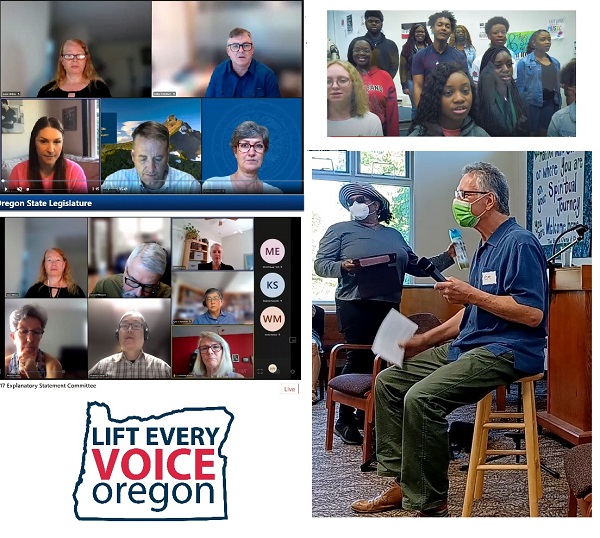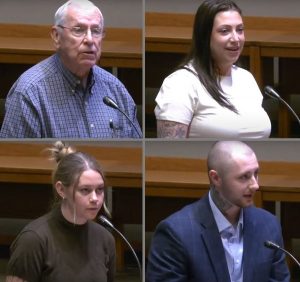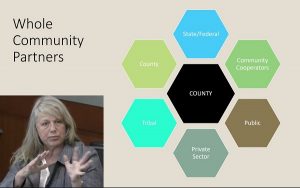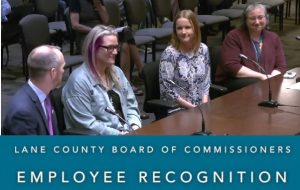Eugene organizer Tom Peck calls for Measure 114 volunteers
8 min read
The faith leaders who put Measure 114 on the ballot have a tradition: Every rally starts with a song.
[00:00:06] Leon County Schools Choir: Lift every voice and sing / Till earth and heaven ring / Ring with the harmonies of Liberty / Let our rejoicing rise / High as the listening skies / Let it resound loud as the rolling sea.
[00:00:42] John Q: Marilyn Keller visited Eugene Aug. 5 to celebrate with local signature gatherers. Thanks to their efforts, Oregonians will vote this November on a measure that seeks to reduce gun violence. Local Eugene organizer Tom Peck.
[00:00:55] Tom Peck (LEVO): Lift Every Voice Oregon, Yes on Measure 114, which I’m sure you all know that we overwhelmed the secretary of state. We needed 112,000 signatures, and got 160,000 signatures. So we— (applause). So yeah, and there was really all of you folks who did it. There was something like 1,800 volunteers across Oregon going out when it was raining and hotter than—you know—yeah, and collecting signatures and so, yes, we are on the ballot for November!
[00:01:37] John Q: Two committees met earlier that day. At the Explanatory Statement meeting, Legislative Analyst Melissa Leoni.
[00:01:44] Melissa Leoni (Legislative Analyst): Good morning, everyone. This is the reconsideration meeting of the Measure 114 / Initiative Petition 17 Explanatory Statement Committee for Aug. 5, 2022, and it is 10:05 a.m.
[00:01:57] John Q: The committee’s draft of the explanatory statement drew significant public comment.
[00:02:03] Emily McLain (Secretary of State office): Emily McLain here on behalf of Secretary of State Shemia Fagan, and to review the public comment that you received, I’ll begin with: There were 657 comments received in writing for Measure 114; 227 of those, our elections staff observed, were automated messages that the committee can review by searching for ‘Grassroots messages.’ Those had identical submissions.
[00:02:35] Another multiple submission, that from what we can find was at least over 40 identical submissions, that you can search in the public testimony dated between July 28 and Aug. 3, by searching, ‘The explanatory statement is seriously flawed.’
[00:02:52] That gives you a sense of the volume of the testimony that was submitted in writing. In terms of verbal testimony, on Aug. 3, nine people testified to the measure. And for the sake of time, Melissa, I’ll give some overview of the verbal testimony and the written testimony. I know that this committee has also been trying to keep up with the volume of testimony, but we acknowledge over 600 comments is a lot to review.
[00:03:22] John Q: As the meeting came to a close, the committee still needed to whittle away a few dozen words.
[00:03:29] Margaret Olney (Explanatory Statement Committee): Is there any way? I mean, I know we can’t have a discussion publicly. Is there anything we can do offline to try to move that process along?
[00:03:42] Melissa Leoni (Legislative Analyst): Again, that’s yeah, Tuesday morning, so folks would need to send me their suggestions, I would say Monday by noon so that I can share it with the group and you all can have a chance to review those. And then we can walk through and I can send you this ‘as is’ now, both with track changes and a clean version so you can see that.
[00:04:03] John Q: For the financial estimate, public comments asked the committee to consider the value of lives saved by the measure.
[00:04:12] Secretary of State Shemia Fagan: I call the Financial Estimate Committee to order. It is Friday, Aug. 5, 2022 at 1 p.m.
[00:04:20] John Q: The committee reviewed several financial estimates, including IP 17.
[00:04:25] Shemia Fagan: And Emily McLain, my chief of staff, is going to join us… Emily, will you please give us an overview of the public testimony? I understand there was quite a bit on IP 17.
[00:04:33] Emily McLain: Yes, thank you, Madam Secretary. So a public hearing, as this committee knows, was held on Aug. 3. That public hearing was held for both the fiscal and the explanatory statements on all of the measures. And for this particular measure, nine individuals testified to the measure, both the fiscal and the explanatory statement. The explanatory statement received hundreds of comments. There were nine received for the fiscal estimate.
[00:05:04] John Q: Several comments asked the committee to acknowledge the value of preventing gun violence.
[00:05:11] Shemia Fagan: Thanks, Emily. Before we dive into the discussion, I just want to acknowledge that obviously, if somebody dies by suicide or by the intentional or accidental shooting of another person, the harm is unquantifiable to that person’s family and friends and loved ones. And I just want to acknowledge that, because I’m sure some of you share my discomfort, that it feels very crude to be talking about these things in terms of financial impact of the state, but that is what this committee is for. So I just want to acknowledge that. I know we all share that understanding that you really can’t quantify the pain and loss to a family when somebody is either injured or dies from a firearm, whether intentionally or accidentally. …
We obviously know—all of us on this committee—that there is much, much greater goods than just financial impact of saving lives. So I just want to acknowledge that.
[00:05:57] John Q: Some costs were based on experience with the Concealed Handgun License (CHL). A question for county sheriffs from State Treasurer Tobias Read:
[00:06:05] State Treasurer Tobias Reed: Some of the public comments suggested that the typical time for the CHL processing is about 20 minutes and the estimate here was two hours. And I know there’s some explanation to that in the written testimony, but I’d be interested in having that a little bit more explicit. That’s obviously a huge implication in the budget.
[00:06:24] From the Oregon State Sheriffs Association, Jason Myers.
[00:06:28] Jason Myers (Oregon State Sheriffs’ Association): Treasurer Reed, Jason Myers from the Sheriff’s Association. We took a look at what the requirements are in this measure versus what the requirements are for a CHL and we feel that they’re very similar in terms of the background and the processes.
[00:06:41] So we did a polling with—there’s 36 sheriff’s offices across the state. They all process CHLs at the sheriff’s office. We did a polling with our CHL managers and professionals, and landed on an average basically per CHL processor/employee that they can, in a year’s time, process about 1,200 CHLs, both new applications and renewals. Renewals obviously go a lot quicker, but that’s where the number we landed at. And it is pretty consistent at every sheriff’s office across the state. Twenty minutes is not accurate. It takes about two hours. We have it broken down in the timeframe. I can actually send that to you piece by piece in the process and how they arrive at the approval.
[00:07:20] Tobias Reed: Good. Okay. And I appreciated your response about what you’ve heard from sheriffs about implementation and glad to hear that all the sheriffs are going to fully implement the measure, if it’s passed by voters, because of course, in the past there were some sitting sheriffs who publicly stated their intention to ignore laws that might be passed based on their own interpretation. So that makes me kind of uneasy and certainly has some uncertainty that that might be included there.
[00:07:47] So I’d love to hear if you can state for the record, in a public meeting here, that all the sheriffs in Oregon are committed to implementing this measure, if voters pass it.
[00:07:56] Jason Myers: I can’t speak for every sheriff in Oregon. They’re all elected officials, but any law that’s passed, I’m not aware of any sheriff that hasn’t followed a law or a vote of the people. Now, when it comes to enforcement with discretion, then there’s— obviously every law enforcement officer has discretion in terms of certain crimes of whether they can enforce them or they decide not to enforce them.
[00:08:22] John Q: Treasurer Read drafted a financial estimate that added the word: indeterminate.
[00:08:28] Shemia Fagan: I agree that we need to somehow capture the fact that really, in the end, this is a somewhat indeterminate fiscal because the whole point of people putting these measures forward is to lead to the reduction in gun violence. And there’s no question that the reduction in gun violence leads to a cost savings in all the ways that have been listed: Incarceration, prosecution, investigations, medical treatments, etc.
[00:08:50] John Q: The committee tackled the final changes in the final draft.
[00:08:53] Shemia Fagan: In the sentence about the savings, it might make more sense to say, ‘There may also be uncertainty in.’
[00:09:00] Tobias Reed: Parallel construction, yeah.
[00:09:02] Shemia Fagan: Yeah, in potential cost savings too… there is uncertainty or there’s also uncertainty because we’re kind of referring to—Live wordsmithing! I’m sure this is riveting for the millions following along at home.
[00:09:19] Tobias Reed: We’ve gotten to that point, Madam Chair. It happens every time we do this process. (It sure does.)
[00:09:26] John Q: The group wrapped up its work on Measure 114’s financial estimate.
[00:09:32] Shemia Fagan: Is there any objection? All right. Seeing none, the motion passes. Thank you again, Treasurer Reed, for your leadership on this and for coming with a prepared statement and for everybody on their thoughtful comments. I think this does well to capture both our discussions, but also I think it does a really good job capturing the public comment on this. I mean, the word ‘indeterminate’ I think is probably the high-level summary of what the public comment on this looked as well.
[00:09:56] John Q: Later on Friday in Eugene, local organizer Tom Peck welcomed Marilyn Keller.
[00:10:01] Tom Peck: We’re honored tonight to have Marilyn Keller here. She is one of three chief petitioners. She’s also a captivating jazz, gospel, and blues singer. And so, she’s going to grace us with some songs today and talk about Lift Every Voice Oregon, what the future plans look like.
[00:10:25] I wanted to thank the First Congregational United Church for providing this place for our gathering. They really were in the forefront of the petition gathering. There was a committee here and they hit the streets—this was also a collection spot. So they did a big service for this petition drive.
[00:10:46] John Q: Marilyn encouraged those who want to help the campaign to sign up for nonviolence training, and to get ready to sing.
[00:10:53] To learn the tunes and words, you can listen to Marilyn Keller at a rally or check out the many performances on YouTube. This is the Leon County Schools choir from Tallahassee.
[00:11:03] Leon County Schools Choir: …Sing a song full of the faith that the dark past has taught us. Sing a song full of the hope that the present has brought us. Facing the rising sun of our new day begun, Let us march on till victory is won.



